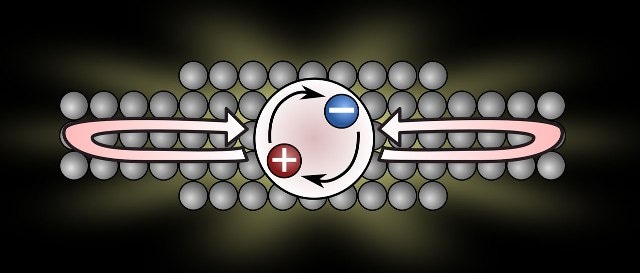May 3 2016
Light sources function by absorbing energy - for instance, from an electric current - and then release this absorbed energy as light. It is important for these light sources to emit light as fast as possible, otherwise the energy can be lost as heat.
 In a quantum dot, there are both negatively charged particles and positively charged particles that are missing electrons (also referred to as holes). The attraction between the electron and hole creates a new quantum state with a very strong light-matter interaction and a corresponding quick release of light. CREDIT: Quantum Photonics Group, Niels Bohr Institute
In a quantum dot, there are both negatively charged particles and positively charged particles that are missing electrons (also referred to as holes). The attraction between the electron and hole creates a new quantum state with a very strong light-matter interaction and a corresponding quick release of light. CREDIT: Quantum Photonics Group, Niels Bohr Institute
Superfast light sources can be used in LED lights, laser lights, and single-photon light sources applicable for quantum technology. The latest research results, presented by the Niels Bohr Institute, highlight the possibility of developing light sources in a rapid manner by following a principle, which was theoretically predicted in 1954. The study results are published in Physical Review Letters.
The researchers are currently working with quantum dots, which are a type of artificial atom that can be integrated into optical chips. An electron can be excited in a quantum dot using a laser to shine a light on it, resulting in an expulsion of the electron from the hole. Powerful interaction between light and matter allows the electron to decay back into the hole rapidly, enabling the light to be emitted faster.
The interaction between light and matter naturally appears to be extremely weak, making the light sources emit light very slowly, reducing energy efficiency. In 1954, the physicist Robert Dicke predicted the possibility of increasing the interaction between light and matter by containing atoms that have the potential to share the excited state in a quantum superposition.
Quantum speed up
An illustration of this effect has until now been a challenging task, because the atoms either come so close to each other that they bump against each other, or they are so far away from each other that restricts the quantum speed. The researchers have finally demonstrated the effect experimentally, but in a totally different physical system than Dicke had in mind. The team demonstrated the superradiance for photons discharged from one quantum dot.
We have developed a quantum dot so that it behaves as if it was comprised of five quantum dots, which means that the light is five times stronger. This is due to the attraction between the electron and the hole. But what is special is that the quantum dot still only emits a single photon at a time. It is an outstanding single-photon source.
Søren Stobbe, Associate Professor, Niels Bohr Institute, University of Copenhagen
The experiment was executed in association with Professor David Ritchie’s research group at the University of Cambridge, who developed the quantum dots.
Petru Tighineanu, a postdoc in the Quantum Photonics research group at the Niels Bohr Institute, has performed the experiments. He explains the effect by pointing out that the atoms are very tiny, and light is extremely ‘big’ due to lengthy wavelength, this makes it difficult for the light to ‘see’ the atoms, for example like a lorry driving on a road and unable to spot a tiny pebble. However, if an increasing number of pebbles become a bigger stone, then it will be possible for the lorry to register it, leading to an interaction that becomes more dramatic. In a similar manner, the interaction of light with the quantum dot becomes stronger if the quantum dot has the unique superradiant quantum state, which makes it appear much larger.
Increasing the light-matter interaction
The increased light-matter interaction makes the quantum dots more robust in regards to the disturbances that are found in all materials, for example, acoustic oscillations. It helps to make the photons more uniform and is important for how large you can build future quantum computers.
Søren Stobbe, Associate Professor, Niels Bohr Institute, University of Copenhagen
He adds that it is in fact the temperature, which is just a few degrees greater than absolute zero that restricts how rapid the light emissions can stay in their existing experiments. The researchers aim at continuing their research on the quantum dots at extremely lower temperatures, which could result in very dramatic effects.
Source: http://www.ku.dk/english/